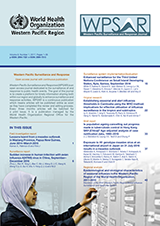Sudden increase in human infection with avian influenza A(H7N9) virus in China, September-December 2016
DOI:
https://doi.org/10.5365/wpsar.2017.8.1.001Abstract
Since the first outbreak of avian influenza A(H7N9) virus in humans was identified in 2013, there have been five seasonal epidemics observed in China. An earlier start and a steep increase in the number of humans infected with H7N9 virus was observed between September and December 2016, raising great public concern in domestic and international societies. The epidemiological characteristics of the recently reported confirmed H7N9 cases were analysed. The results suggested that although more cases were reported recently, most cases in the fifth epidemic were still highly sporadically distributed without any epidemiology links; the main characteristics remained unchanged and the genetic characteristics of virus strains that were isolated in this epidemic remained similar to earlier epidemics. Interventions included live poultry market closures in several cities that reported more H7N9 cases recently.
References
Li Q, Zhou L, Zhou M, Chen Z, Li F, Wu H, et al. Preliminary Report: Epidemiology of the Avian Influenza A (H7N9) Outbreak in China. N Engl J Med. 2013. doi:10.1056/NEJMoa1304617.
----------------------------------------------------------------------
N Xiang, X Li, R Ren, et al. Assessing Change in Avian Influenza A (H7N9) Virus Infections During the Fourth Epidemic—China, September 2015–August 2016[J]. MMWR. Morbidity and Mortality Weekly Report, 2016, 65.
----------------------------------------------------------------------
Xiang N, Iuliano A D, Zhang Y, et al. Comparison of the first three waves of avian influenza A (H7N9) virus circulation in the mainland of the People’s Republic of China[J]. BMC Infectious Diseases, 2016, 16(1): 734.
----------------------------------------------------------------------
National Health and Family Planning Commission of PRC. Protocol for Diagnosis and Treatment for Human Infection with A(H7N9) Influenza Virus (2014 version). [http://www.nhfpc.gov.cn/yzygj/s3593g/201401/3f69fe196ecb4cfc8a2d6d96182f8b22.shtml]. Accessed 26 Jan 2014.
----------------------------------------------------------------------
Liu B, Havers F, Chen E, et al. Risk factors for influenza A(H7N9) disease–China,
Clin Infect Dis 2014; 59:787–94.
----------------------------------------------------------------------
http://www.suzhou.gov.cn/news/szxw/201612/t20161225_831175.shtml.
----------------------------------------------------------------------
http://www.wuxi.gov.cn/doc/2016/07/15/1106288.shtml.
----------------------------------------------------------------------
http://www.changzhou.gov.cn/ns_news/209148297210161.
----------------------------------------------------------------------
http://www.zj.gov.cn/art/2014/6/4/art_12455_161981.html.
----------------------------------------------------------------------
http://zwgk.gd.gov.cn/006939748/201412/t20141215_559975.html.
----------------------------------------------------------------------
http://www.moa.gov.cn/govpublic/SYJ/201406/t20140625_3950377.htm
----------------------------------------------------------------------
Zhou L, Ren R, Ou J, et al. Risk factors for influenza A (H7N9) disease in China, a matched case control study, October 2014 to April 2015[C]//Open Forum Infectious Diseases. Oxford University Press, 2016, 3(3): ofw182.
----------------------------------------------------------------------
Yu H, Wu J T, Cowling B J, et al. Effect of closure of live poultry markets on poultry-to-person transmission of avian influenza A H7N9 virus: an ecological study.[J]. Lancet, 2014, 383(9916):541-8.

